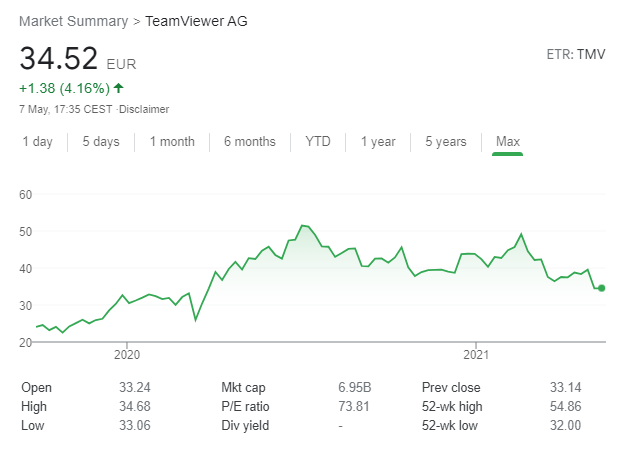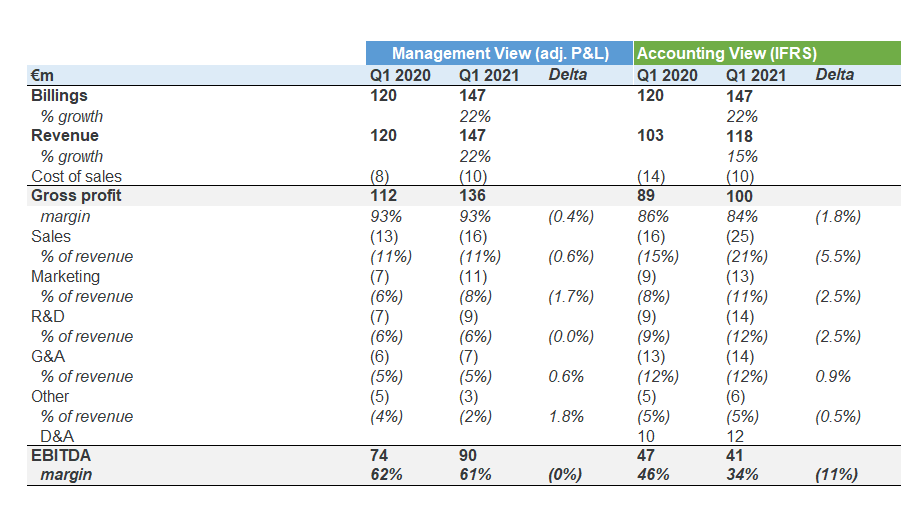TeamViewer - Q1 21 Earnings Breakdown
Taking a closer look at TeamViewer's latest quarterly earnings
I am a huge fan of European tech and want to increase awareness of interesting listed tech businesses by writing company deep dives (similar to this one). As part of the research process, I have started tracking some European names and analysing their quarterly earnings. I found TeamViewer’s latest earnings quite interesting and wanted to share some initial thoughts on the business ahead of a deep dive. Please feel to reach out if you would like to share any feedback / discuss the company in detail.
Company Overview
Launched in 2005 and based in Germany, TeamViewer is a leading global cloud-based connectivity platform that enables users to connect to a wide network of different devices in order to: (i) control, manage, monitor and prepare these devices; (ii) assist users with daily problems and interact digitally with each other. While the company has expanded its product portfolio, it is primarily known for its remote access solution, used by IT. Listed in Germany, the company has a market cap of €7.0bn / $8.5bn.
Q1-21 Financial Performance
Background
In 2020, COVID-19 accelerated TeamViewer’s fundamental growth drivers as restrictions on mobility made remote access and collaboration functions critical to business success. In 2020, the company generated €460m in revenues (+42% y-o-y) and EBITDA of €261m (+44% y-o-y). Therefore, it should be classified as a clear WFH beneficiary as the company experienced incremental demand from COVID-19. As a result, TeamViewer’s share price did exceptionally well last year.
On 4th May 2021, the company announced their Q1-21 financial results and the share price declined by c.10%. While the company announced good billings growth and resilient margins, Q1-20 provides a tough comparison base for the financial performance this year as acknowledged by the management during the earnings calls.
Key Financial Highlights
The table above shows the Q1-20 and Q1-21 P&L in management view and accounting view. The difference in the “views” are due to non-IFRS adjustments such as deferred revenue, share-based compensation, one-off items. For the purpose of commentary below, I will use the financials from the management view.
A) Billings / Revenue: TeamViewer generated €147m in billings in Q1-21 (22% growth yoy on tough comps). There were a couple of factors that affected billings growth including:
Increase in number of subscribers: In Q1-21, the company won additional 173 enterprise customers with an annual contract value of +€10k.
Net retention remained at 100%
Gross Churn: Subscriber churn of 15% (“retained subscribers amount to 437k compared to 514k at Q1-20”)
Upsell/ Cross-sell: The company saw ACV expansion in the enterprise segment and a general shift of ACVs of €250k or more
Down-sell: There has been “some rightsizing and proper procurement procedures of corona-driven subscribers” as anticipated by the company
Price changes: The company has introduced selective price increases, which excludes all COVID customers.
B) Gross Margin: Gross margins have been resilient and above 90%, showing that the infrastructure is very scalable.
C) Sales Expenses: Over the last 12 months, the company has grown the number of employees by more than 40%, including significant additions to sales force. Therefore, the sales expenses have increased in absolute terms but have stayed constant as % of billings. It should be noted that the sales expenses have significantly increased under Accounting View - this is likely due to increased expenses from share-based compensation (variable cost) due to significantly higher billings as well as M&A related share-based compensation.
D) Marketing Expenses: As the company wants to position their enlarged product portfolio, it has significantly increased discretionary marketing spend (more details in the next section).
E) Adj. EBITDA Margin: In Q1-21, the company achieved c.60% EBITDA margin, virtually unchanged from Q1-20 despite continuous investments (management view).
Key Takeaways
The company has shown solid billings growth but will experience tough comps in the next 1-2 quarters. Furthermore, it is unclear to me whether COVID has primarily pulled forward future demand vs. created incremental temporary or permanent demand. Therefore, it will be interesting to see how the COVID cohort behaves relative to other cohorts in the coming quarters. It should be noted that the company is laser-focused on retaining these customers. Furthermore, the margins are very resilient, and the management has exerted cost discipline, which is great to see.
Operational Performance - Key Highlights
Focus on cross-sell and higher ACV accounts
The company is focused on two inter-connected strategic drivers to grow the business. Firstly, the company wants to sell more seats for each product/ use case per company (effectively targeting larger enterprises and/or increasing the share of wallet in existing customers). Secondly, the company wants to sell more products / use cases per company (effectively targeting different workflows within a company). Further details below:
(a) Use case / Product expansion: Historically known for its remote monitoring tool, the company has expanded its product capabilities, often through acquisitions. Product expansion has enabled the company to significantly increase its TAM. As an example, the company acquired Upskill and Frontline to increase their AR capabilities. The company does not provide billings breakdown by product category / use case as product expansion is in its early innings. However, I believe that use case expansion will be one of the key drivers for the business in the long term.
(b) Focus on larger enterprises: The company is also targeting higher ACVs in the enterprise segment (selling more seats per product within one enterprise), which requires a strong direct sales team, justifying increased investments in sales force.
Sponsorship Deals
To turn TeamViewer into a global tech brand, the company signed a strategic five-year partnership with Manchester United and Mercedes racing teams in Formula 1 and Formula E. The company expects these partnerships to deliver higher and longer growth 2023-2025 and beyond (expected €150m incremental billings in 2025) but they will be dilutive to margins in the coming years (2021 guidance for EBITDA margin lowered from 55-57% to 49-51%). When TeamViewer announced the Manchester United deal, the share price plunged by 16% as it represented a significant shift from previous management plans. The investors need some time to digest these sponsorship deals.
I think that the marketing deals have 2 important signal effects for investors. The management’s decision to invest in marketing vs. R&D and/or sales force can be a “mixed” signal. Management effectively took the view that these marketing deals offered the highest return on investment relative to (a) R&D, (b) sales force expansion and/or (c) M&A. While TeamViewer is a freemium product, it is not a consumer brand per se. In contrast, previous Manchester United sponsors included Chevrolet, AIG, Sharp and Vodafone, which have a clear consumer angle. Separately, it shows that the management is thinking long-term, which is a good signal (these deals would lead to short term pain (lower margins) but long term gains (incremental billings growth)).
Illustrative Valuation Considerations
Based on the latest share price (€35), the company trades on a 25x EV / 21E EBITDA and 20x EV / 22E EBITDA multiple. The company is expected to grow revenues at 29% (21-22E) with 56% 21E EBITDA margin. It implies a score of 85 on Software’s Rule of 40, which is exceptional.
Sources
Company Materials
Koyfin, Google Finance
Disclaimer
This post and the information presented are intended for informational purposes only. The views expressed herein are the author’s alone and do not constitute an offer to sell, or a recommendation to purchase, or a solicitation of an offer to buy, any security, nor a recommendation for any investment product or service. While certain information contained herein has been obtained from sources believed to be reliable, neither the author nor any of his employers or their affiliates have independently verified this information, and its accuracy and completeness cannot be guaranteed. Accordingly, no representation or warranty, express or implied, is made as to, and no reliance should be placed on, the fairness, accuracy, timeliness or completeness of this information. The author and affiliated persons and companies assume no liability for this information and no obligation to update the information or analysis contained herein in the future.








